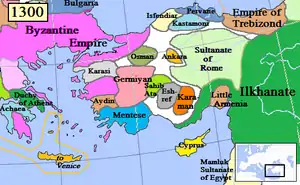| Yaʿḳūb I | |
|---|---|
| Bey of Germiyan | |
| Reign | c. 1300 – c. 1340 |
| Successor | Meḥmed Chakhshādan |
| Died | c. 1340 |
| Issue | |
| Dynasty | Germiyan |
| Father | Karim al-Dīn ʿAlī Shīr |
| Religion | Islam |
Yaʿḳūb I (died c. 1340) was the founder of the beylik of Germiyān, around Kütahya in western Anatolia. During the thirteenth century, members of Germiyān fought for the Sultanate of Rum against Baba Ishāq in 1239 near Malatya and later Jimrī in 1277 in western Anatolia. Yaʿḳūb was the son of Karim al-Dīn ʿAlī Shīr. Although he initially accepted vassalage under Kayḳobād III, the Sultanate of Rum disintegrated shortly after. Yaʿḳūb was the suzerain of many of his neighbors, and his reign was described as being economically prosperous. He was succeeded by his son Meḥmed, nicknamed Chakhshādan.
Background
The Germiyān first appeared in 1239 under Kaykhusraw II's rule of the Sultanate of Rum. "Muẓaffar al-Dīn," referred to as the son of ʿAlī Shīr, appears in the area around Malatya tasked to subdue Baba Ishāq with an army of Kurds and Germiyān Turkmens under his command. In 1277, "Ḥusām al-Dīn," son of ʿAlī Shīr, fought against Jimrī and Meḥmed of Karaman in western Anatolia.[1]
Reign
The Germiyān attempted to declare independence from the Sultanate of Rum when Masʿūd II became the sultan following the execution of his father, Kaykhusraw III, by the Mongols in 1283. Upon Masʿūd's end, however, Yaʿḳūb, whose realm extended until Ankara accepted vassalage under Kayḳobād III. Al-ʿUmarī describes him as the most powerful Turkish emir, being the suzerain of many of his neighbors, with the Byzantine Empire paying him 100,000 pieces of gold each year. His domain included Denizli and Karahisar according to Nicephorus Gregoras and Tripolis on the Meander according to George Pachymeres. He conquered the regions of Simav and Kula, which were later recaptured by the Catalan Company. Similarly, Yaʿḳūb seized control of Alaşehir, which was lost to the Catalans in the spring of 1304 but started paying him jizya by 1314. The region, under him, was economically prosperous[1] and saw an increase in literary and scientific patronage.[2] Rumi's grandson Ulu Arif Chelebi visited the region by 1312 and maintained spiritual authority over Yaʿḳūb. On the other hand, Yaʿḳūb had hostile relations with the Ottoman state, who were attacked by Tatars of the Chavdar tribe near Karacahisar in 1313 upon Germiyānid provocation. Following the elimination of the Hamidid and Eshrefid begs amidst Ilkhanid involvement in Anatolia in 1325, Germiyān attempted to seize the territory of Alaşehir, Denizli, and Menteshe. Moreover, Yaʿḳūb's son-in-law, who was the lord of Karahisar, fled to Kütahya from the Ilkhanid officer Eretna. When Yaʿḳūb was about to engage in a battle with Eretna, the latter was called back by his master Tīmūrtāsh in 1327. Yaʿḳūb is known to have exchanged letters with the Mamluk Sultanate in 1340.[3]

According to Al-ʿUmarī, who relayed traveler Haydar al-Uryan and Balaban's observations, Yaʿḳūb's domains housed about 700 settlements. He possessed 40,000 cavalry and although exaggerated, was able to raise 200,000 troops in times of war.[3] Yaʿḳūb struck a single type of coin late into his reign.[4] His exact death year is unknown. According to Evliya Çelebi, he was buried at the hill of Hıdırlık near Kütahya.[2] Meḥmed, nicknamed Chakhshādan, was the son and successor of Yaʿḳūb. According to a deed from 1363, he also had a brother named Musa.[3]
References
- 1 2 Mélikoff 1965.
- 1 2 Varlık 2013, p. 279.
- 1 2 3 Varlık 1996, pp. 33–35.
- ↑ Foss 2022, p. 210.
Bibliography
- Bosworth, Clifford Edmund (1996). New Islamic Dynasties: A Chronological and Genealogical Manual. Edinburgh University Press.
- Foss, Clive (2022). The Beginnings of the Ottoman Empire. Oxford University Press.
- Mélikoff, I. (1965). "Germiyān-Og̲h̲ullari̊̊". In Lewis, B.; Pellat, Ch. & Schacht, J. (eds.). Encyclopaedia of Islam. Volume II: C–G (2nd ed.). Leiden: E. J. Brill. OCLC 495469475.
- Varlık, Mustafa Çetin (1996). "Germiyanoğulları". TDV Encyclopedia of Islam, Vol. 14 (Geli̇bolu – Haddesenâ) (in Turkish). Istanbul: Turkiye Diyanet Foundation, Centre for Islamic Studies. pp. 33–35. ISBN 978-975-389-441-8.
- Varlık, Mustafa Çetin (2013). "Yâkub Bey". TDV Encyclopedia of Islam, Vol. 43 (Vekâlet – Yûsî) (in Turkish). Istanbul: Turkiye Diyanet Foundation, Centre for Islamic Studies. pp. 278–279. ISBN 978-975-389-754-9.